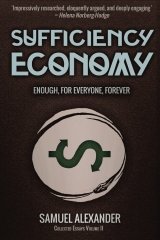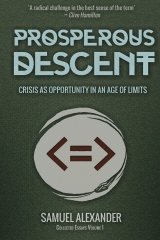
Earth as a Petri Dish: The Problem of Growth
Republished with permission from https://simplicitycollective.com/earth-as-a-petri-dish-the-problem-of-growth
The 1972 publication of Limits to Growth sparked a controversy that has yet to subside. This book argued that if population, resource use, and pollution kept growing on our finite planet, eventually economies would face environmental ‘limits to growth’ – with potentially dire consequences.
Despite the evidence mounting in support of this position, any suggestion that we might have to give up economic growth, or even embrace a degrowth process of planned economic contraction, is typically met with fierce resistance – especially by economists.
Last week I was invited into the Faculty of Business and Economics at the University of Melbourne to defend this radical ‘degrowth’ perspective. I felt like I had been lured into the lion’s den, and was at risk of being eaten alive. But I made it out unscathed to tell my tale, and would like to report on my findings.
As I entered the lion’s den my aim was not so much to convince the Faculty of my view but to ‘deconstruct the debate’, so to speak, in the hope of facilitating a discussion about the areas of disagreement in a fruitful and hopefully non-violent manner.
After considering the objections to degrowth, here’s my summary view of why this ‘limits to growth’ position remains controversial – and why, in the end, the economists that dismiss this perspective are wrong.
What is growth?
If someone is to be for or against ‘growth’ it is important to know what that term means, so in the interests of rigour and clear thinking let’s begin with some definitions. There are four primary ways to understand growth.
First, growth can mean an increase in the energy and resource demands of an economy. This is often called ‘extensive’ or ‘quantitative’ growth. This form of growth represents an increase in the quantity of inputs into the economy (e.g. labour, resources, energy, etc.) in order to increase the quantity of the outputs.
Secondly, growth can also mean using the same resource inputs but doing more with them. This is often called ‘intensive’ or ‘qualitative’ growth. This form of growth occurs when the same resource inputs are used more efficiently, through better skills, technology, or design. This can be understood as increased productivity per unit of input.
Thirdly, growth can refer to increases in Gross Domestic Product (or GDP). GDP is a macroeconomic accounting system that measures the overall market value of all the goods and services a country produces over a given period. This is perhaps the dominant understanding of growth. When most people think of a growing economy, or when our politicians talk of growth, or when growth is mentioned on the news every night, it is almost always in terms of growth in GDP.
Finally, growth can sometimes be used to refer to state of progress where societal wellbeing or overall utility is increased.
These are all legitimate ways to understand the notion of growth but they are not synonymous. One form of growth may or may not lead to another form of growth; some forms of growth may have limits, others may not. Fuzzy thinking about these four types of growth has produced unnecessary disagreement.
Where, then, does the ‘limits to growth’ controversy lie?
Deconstructing the debate
Nobody is against growth in wellbeing, so we can leave that to one side. Furthermore, even economists tend to accept that an economy cannot grow quantitatively without limit on a finite planet.
The real controversy over the ‘limits to growth’ perspective lies in relation to the concepts of GDP and qualitative growth. Defenders of growth argue that there is no reason why we cannot ‘decouple’ GDP growth from environmental impact in such a way that avoids any perceived limits to growth.
These growth advocates might acknowledge that current forms of GDP growth are not sustainable, but nevertheless argue that what we need is ‘green growth’; that is, growth based in qualitative improvement not quantitative expansion.
This view is based in economic theory. It argues that if natural resources begin to get scarce, prices will go up, and this will set in motion two important dynamics. First of all, increased prices will dis-incentivise consumption of that resource and encourage alternatives or substitution, thus reducing demand of the scarce resource.
Secondly, increased prices would incentivise the development of new technologies, new markets, or new substitutes, which will increase the production of the scarce resource and lead to its more efficient use.
Furthermore, when markets are working properly and all the costs of production are ‘internalised’, the prices that result will mean people will only ever consume natural resources or pollute the environment to an ‘optimal’ degree. The ‘invisible hand’ will ensure that utility is maximised.
For all these reasons, modern economists tend to argue that human economic activity will never face limits to growth. Those silly ‘limits to growth’ theorists just don’t understand economics. Growth is good, and more growth is better!
This is the mainstream economic justification underpinning calls for ‘sustained growth’ as the path to sustainable development. In short: all nations on the planet should continue to pursue growth in GDP, while aiming to ‘decouple’ that growth from environmental impact.
Coherent in theory, flawed in practice
I am prepared to accept (for present purposes) that these economic arguments for why there are no limits to growth are coherent in theory. And because they are coherent enough in theory, many people are persuaded by them, making the limits to growth perspective seem controversial or just false. Nevertheless, the attempts to avoid limits to growth are demonstrably flawed when applied in practice.
Tim Jackson, for example, has shown that if the developed nations grew GDP by 2% over coming decades and by 2050 the global population had achieved a similar standard of living, the global economy would be 15 times larger than it is today. If it grew at 3% from then on it would be 30 times larger than the current economy by 2073, and 60 times larger before the end of this century.
Given that the global economy is already in gross ecological overshoot, just imagine the environmental burdens of a global economy fifteen, thirty, or sixty times bigger than today. What makes this growth trajectory all the more terrifying is that if we asked politicians whether they’d prefer 4% growth to 3%, they’d all say yes, and the exponential growth scenario just described would become even more absurd. It seems too much growth is never enough.
Here we see the fatal flaw at the heart of growth economics: the apparent failure to understand the exponential function. By all means, let’s do our very best to decouple GDP from environmental impact – that’s absolutely necessary. But let’s think through the very basic arithmetic of growth and recognise that compound growth quickly renders the growth model a recipe for ecological and thus humanitarian disaster.
In short, the main problem with the growth model is that it relies on an extent of ‘decoupling’ that quickly becomes unachievable. Granted, we might be able to produce food more efficiently than we do today, but we cannot eat recipes!
To make matters worse, recent evidence has debunked the widespread myth that the developed nations are already in the process of achieving significant decoupling. It turns out that what we’ve mainly been doing is out-sourcing our energy and resource intensive manufacturing and ‘recoupling’ it elsewhere, especially in China. So much for green growth. We’re just cooking the books.
As I have argued elsewhere, continued growth in GDP is also incompatible with the goal of avoiding dangerous climate change.
Earth as a Petri dish
I think everyone who casually dismisses the limits to growth perspective should be given a Petri dish with a swab of bacteria and watch as the colony grows until it consumes all the available nutrients or is poisoned by its own waste.
In that light, I ask you to imagine a world of seven billion people, trending towards eleven billion people, all aspiring to the Western way of life, on our one and only planet, and consider for a moment whether the first limits to growth theorist, Thomas Malthus, who is often ridiculed, may yet have the last, tragic laugh.
From a distance, I think Earth would look very much like that Petri dish I just mentioned.
———–
Samuel Alexander – is a lecturer with the Office for Environmental Programs and research fellow at the Melbourne Sustainable Society Institute (MSSI), University of Melbourne. He also co-directs the Simplicity Institute.
Samuel has just published his second book of collected essays, Sufficiency Economy: Enough, for Everyone, Forever. This is the companion volume to Prosperous Descent: Crisis as Opportunity in an Age of Limits, published earlier this year.
The paperback of Sufficiency Economy is available here. For those unable to pay or who would like an electronic version, the pdf is available on a ‘pay what you want’ basis here.
The paperback of Prosperous Descent is available here. The pdf of this book is also available on a ‘pay what you want’ basis here.
Editor Note:
Samuel is very knowledgeable and has written quite a number of well constructed articles. Please take this opportunity to review his books and support his endeavours, by either purchasing the paperback version’s or his generous option to “pay what you want” PDF version’s.














